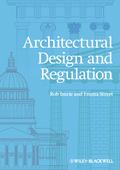
INDICE: Part 1: The context of regulation.The first part of the book outlines the role and significance of codes and regulations relating to the design of the built environment. It provides historical and contextual discussion of what codes and regulations are, and how and why they have emerged to regulate design and building processes. It outlines the institutional and/or governance structures in and through which codes and regulations have emerged. It develops key concepts relating to risk as a way of understanding the role and significance of regulation and the design process.Chapter 1: The significance of regulation.Chapter 2: Regulation and the design process.Chapter 3: Standards and the regulation of architecture. Part 2: The practices of regulation.This part of the book explores how design and/or building standards and regulations influence architects practices, and with what implications for the form and contentof the built environment. It refers to the empirical data gathered as part ofan Arts and Humanities Research Council project. As already outlined, this included scoping interviews with urban design professionals, a postal survey of 800 UK architects, follow up depth interviews, ethnography research in two architectural practices, cases studies of design codes, interviews with other development professionals, and collection of documents and photographs. Interviews with urban design professionals and architects were also conducted in the USA, and this material is drawn on in the following chapters to develop points of contrast with the UK.Chapter 4: Learning about regulation.Case study: The teaching of regulation in architectural school.Chapter 5: Working with regulation.Case study: The shaping of regulation and design outcomes.Chapter 6: The influence of regulation on architecture.Case study: Regulation and straw bale building techniques in the United States. Part 3: The scope of regulation.This part of the book widens the understanding of the regulation of architecture to encompass the roles of specific aspects of the design process relating to specification, procurement, and design codes. Rules and regulations relating to design are broader than planning and building control, and most architects argue that design outcomes are not unrelated to contractual relations with other actors.Chapter 7: Risky behaviour: specification, procurement, and regulation.Case study: procuring the London Olympics.Chapter 8: The coding of design and architecture.Case study: The influence of design codes on architects practices.Chapter 9: The interrelationships between regulation and architects practices.
- ISBN: 978-1-4051-7966-9
- Editorial: Wiley-Blackwell
- Encuadernacion: Cartoné
- Páginas: 368
- Fecha Publicación: 11/02/2011
- Nº Volúmenes: 1
- Idioma: Inglés
